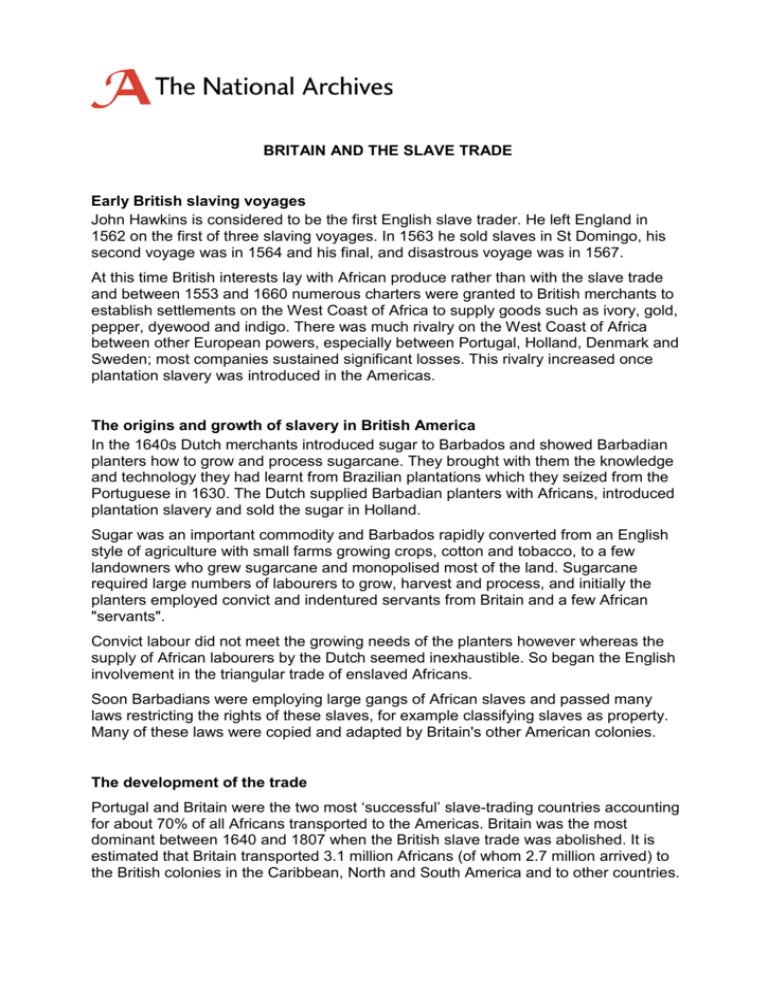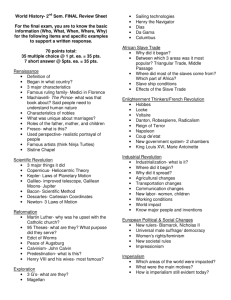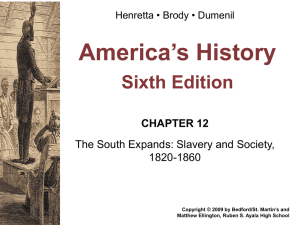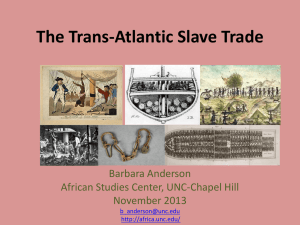Britain and the Slave Trade
advertisement

BRITAIN AND THE SLAVE TRADE Early British slaving voyages John Hawkins is considered to be the first English slave trader. He left England in 1562 on the first of three slaving voyages. In 1563 he sold slaves in St Domingo, his second voyage was in 1564 and his final, and disastrous voyage was in 1567. At this time British interests lay with African produce rather than with the slave trade and between 1553 and 1660 numerous charters were granted to British merchants to establish settlements on the West Coast of Africa to supply goods such as ivory, gold, pepper, dyewood and indigo. There was much rivalry on the West Coast of Africa between other European powers, especially between Portugal, Holland, Denmark and Sweden; most companies sustained significant losses. This rivalry increased once plantation slavery was introduced in the Americas. The origins and growth of slavery in British America In the 1640s Dutch merchants introduced sugar to Barbados and showed Barbadian planters how to grow and process sugarcane. They brought with them the knowledge and technology they had learnt from Brazilian plantations which they seized from the Portuguese in 1630. The Dutch supplied Barbadian planters with Africans, introduced plantation slavery and sold the sugar in Holland. Sugar was an important commodity and Barbados rapidly converted from an English style of agriculture with small farms growing crops, cotton and tobacco, to a few landowners who grew sugarcane and monopolised most of the land. Sugarcane required large numbers of labourers to grow, harvest and process, and initially the planters employed convict and indentured servants from Britain and a few African "servants". Convict labour did not meet the growing needs of the planters however whereas the supply of African labourers by the Dutch seemed inexhaustible. So began the English involvement in the triangular trade of enslaved Africans. Soon Barbadians were employing large gangs of African slaves and passed many laws restricting the rights of these slaves, for example classifying slaves as property. Many of these laws were copied and adapted by Britain's other American colonies. The development of the trade Portugal and Britain were the two most ‘successful’ slave-trading countries accounting for about 70% of all Africans transported to the Americas. Britain was the most dominant between 1640 and 1807 when the British slave trade was abolished. It is estimated that Britain transported 3.1 million Africans (of whom 2.7 million arrived) to the British colonies in the Caribbean, North and South America and to other countries. The early African companies developed English trade and trade routes in the 16th and 17th centuries, but it was not until the opening up of Africa and the slave trade to all English merchants in 1698 that Britain began to become dominant. The slave trade was carried out from many British ports, but the three most important ports were London (1660-1720s), Bristol (1720s-1740s) and Liverpool (1740s-1807), which became extremely wealthy. Under the1799 Slave Trade Act, the slave trade was restricted to these three ports. Later African companies As the British American colonies demanded African slaves, the role of the African companies changed to supply them. From 1660, the British Crown passed various acts and granted charters to enable companies to settle, administer and exploit British interests on the West Coast of Africa and to supply slaves to the American colonies. The African companies were granted a monopoly to trade in slaves. This monopoly was criticised by other traders, and planters complained about restricted rights, limited supplies and high prices. This encouraged illegal traders (commonly called interlopers), many of whom were from other nations, especially the Dutch. Opposition from planters, traders and manufacturers was so strong that in 1698 the monopoly was removed. Detail from records of the Royal African Company, catalogue reference: T 70/1623 Intense rivalry, illegal traders and the loss of monopoly meant that the African settlements were not as successful as they could be. The British government intervened on several occasions to grant new charters, pass acts to improve trade, subsidise the company and eventually take over the settlements. In addition to the African companies, other companies set up under Royal charters were involved in the slave trade. For example, the East India Company was involved in the East African slave trade but also collected slaves from the West Coast of Africa for its settlements in South and East Africa and in India and Asia. Map showing slave fort locations, catalogue reference MPG 1/221 Abolition of the British transatlantic slave trade The abolition of the British slave trade did not only affect the trade in British and colonial based vessels, but also the supplying and fitting of vessels by British workers for the slave trade, the manning of slaving ships by British sailors, and the insuring of slaving vessels. Ships, which had lawfully been cleared to leave British ports before 1 May 1807, could trade until 1 March 1808. According to The trans-Atlantic slave trade database, 34 ships left Britain on or after 1 May 1807 by which it is assumed that the ships had to have received their passes for clearance before 1 May, but had to leave with sufficient time in order to trade and deliver their slaves before 1 March 1808. The Abolition of the Slave Trade Act, along with subsequent Acts tightening up the provisions for monitoring and suppressing the trade and international treaties with European and American countries, gave Britain the role of international policeman. Following the passing of the Act, British naval squadrons were set up to patrol the coast of West Africa and the Caribbean looking out for illegal slavers. The Navy also encouraged exploration of the coastal rivers and waterways, bombarded slaving settlements, made treaties with friendly African groups and encouraged other forms of trade such as in palm oil. Britain's diplomatic role led to treaties with slave owning and slave trading countries (such as Spain, the Netherlands and Portugal) if not to stop the slave trade at least to manage it better. This led to the gradual suppression of the slave trade and slavery throughout the Americas and to a lesser extent in Africa, the Middle East, India and the Far East.







